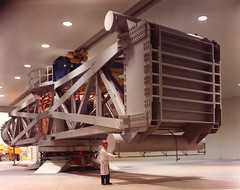Last night I watched In the Shadow of the Moon, Ron Howard's documentary featuring interviews with the men who actually flew the missions and landed on the moon. It was riveting! Men who had seemed so much larger than life in their younger days talked honestly about their participation in this amazing endeavor.
You really sensed their excitement and their honest apprehension as well. They were setting off into uncharted territory and they knew full well the risks. Most of them had flown combat missions and had gone on to become test pilots before joining the space program. They talked openly about the majesty of cosmic order and Charlie Duke gave testimony of how he came to faith in G-d.
Towards the end of the film, all of them expressed gratitude for being born at the right time to be a part of this amazing journey. They all were born in 1930 or close to that time. And here's the amazing thing about that. If you remember your history you are looking at about a year into the great depression. These men grew up in hard and bleak looking times. They got into flying at the end of a terrible conflict and flew experimental aircraft at a time when the stakes were considered pretty high.
The Soviets and the Americans had captured Hitler's missle scientists and were rushing to build ICBMS. Sputnik and Yuri Gagarin had us at 2 - 0. Alan Shepard flew a 15 minute lob into the ocean and then John Kennedy made a bold stroke. He laid out the mission to put a man on the moon "...and return him safely to Earth!" In this decade.
So much of the required technology had to be invented. A lot of medical advances like replacement heart valves and artificial hips, guess where they came from. Environmental science is another spin-off. There were no satellites monitoring pollution over Nineteenth-century Birmingham, England but now we can see exactly what we produce and where it goes [or doesn't go, as in Los Angeles]. The alternative technologies we must develop now involve innovations that came from the space program.
I hope the next American president will lay down a similar challenge. We should become energy independent in the next decade, with an even longer term development of cleaner, more efficient technologies. May our grandchildren be able to express their gratitude for being born at the right time to be a part of this amazing journey!

My father's contribution to the space program was in leading the team designing this 'Launch Phase Simulator.' This amazing machine was used to test spacecraft components by subjecting them to increased g forces, vibration, vacuum, cooling and solar baking. All of which would be felt during launch into outer space. You are looking at the counterweight end of what was basically a giant centrifuge. A vacuum chamber on the far end was where the component to be tested was bolted to a vibrator. High intensity lamps and cryogenic systems were used to simulate the extremes of temperatures.
No comments:
Post a Comment